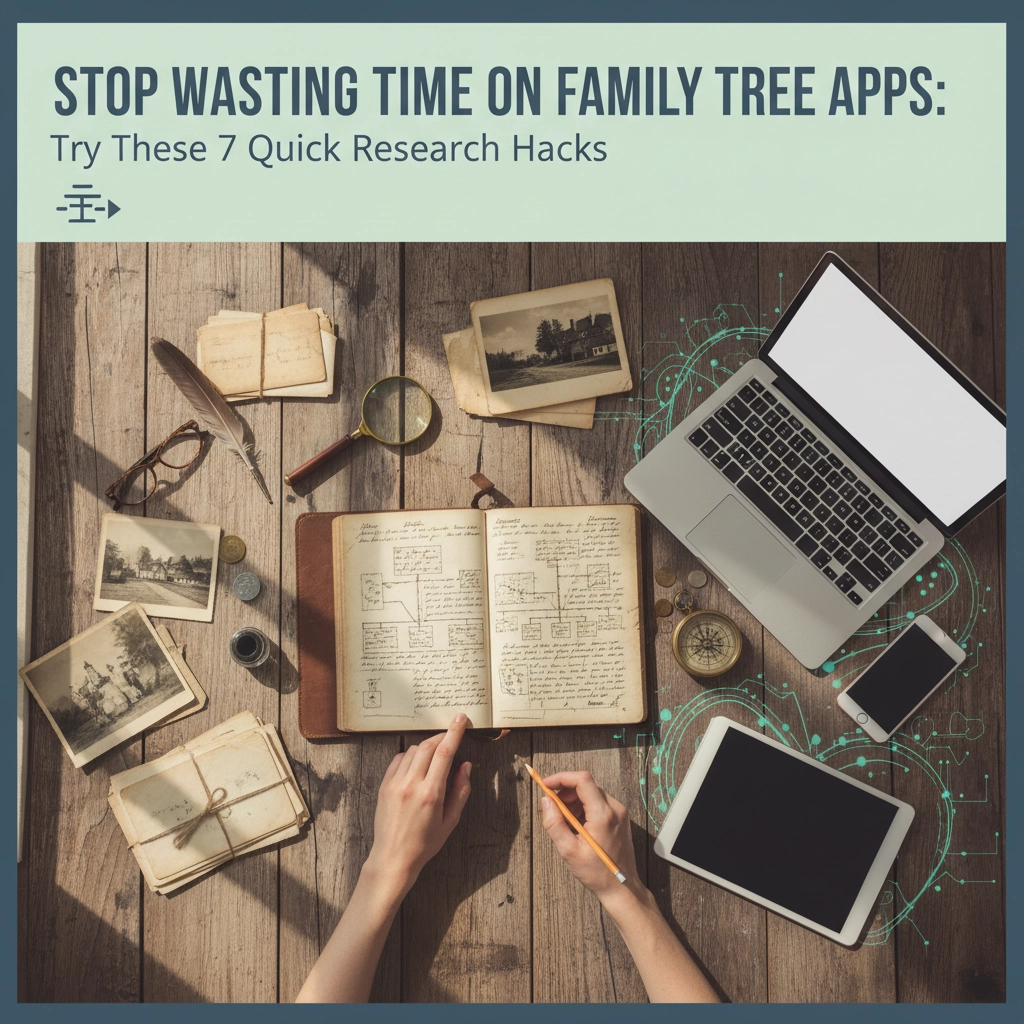
Are you spending hours clicking through family tree apps only to feel like you’re wandering through a maze blindfolded? You’re not alone. Many genealogy enthusiasts fall into the trap of endless browsing, jumping from one fascinating record to another without making real progress on their family history. It’s time to transform your research from a time sink into a precision instrument.
Whether you’re an Acadian tracing your roots back to 17th-century settlements or simply interested in uncovering your family’s story, these seven research hacks will revolutionize how you approach genealogy. Think of them as your secret weapon against wasted hours and research frustration.
Hack #1: Set Your Research Timer and Stick to It
The biggest enemy of productive genealogy research? The rabbit hole effect. You start looking for one ancestor’s birth record and three hours later, you’re reading about their third cousin’s military service in a completely different war.
Here’s your game-changer: Set a strict timer before you begin each research session. Whether it’s 30 minutes during your lunch break or two hours on a weekend morning, that timer is your research lifeline. When it goes off, stop. No exceptions.
Professional genealogists swear by this technique because it forces you to maintain laser focus. Without a time limit, your brain knows it has all day to meander. With one, every click becomes intentional. Try scheduling your genealogy time before other commitments – like allowing yourself one hour before helping the kids with homework. That natural deadline will keep you sharp and prevent the “just one more document” mentality that devours entire afternoons.

Hack #2: Enter Every Session with a Mission
Walking into genealogy research without a plan is like going grocery shopping when you’re hungry – you’ll come out with everything except what you actually need. Before you open that family tree app, write down your specific research objective.
Your mission might be:
- Find the immigration record for great-grandfather Pierre
- Locate all census records for the Leblanc family between 1880-1920
- Research military service records for Uncle Thomas
- Verify the birth location of grandmother Marie
Notice how each goal is specific and measurable? That’s intentional. Vague objectives like “research the Smith family” lead to scattered efforts and minimal progress. When you have a clear target, you’ll resist the temptation to chase every interesting surname that pops up in your peripheral vision.
Keep a running list of research objectives so you’re never scrambling for direction when you sit down to work. This simple strategy alone can double your research productivity.
Hack #3: Master the Art of Smart Filtering
When a search returns 2,847 results, don’t panic – and definitely don’t start clicking through them one by one. Your secret weapon lies in mastering advanced search filters, turning that overwhelming flood of information into a manageable stream.
Start broad, then narrow systematically. Begin with the most likely location – if you suspect your ancestor lived in Nova Scotia, start there rather than searching all of North America. For dates, use the ±10 year rule initially. If you think someone was born around 1850, search 1840-1860 first, then tighten the range based on what you find.
Pro filtering strategy: Layer your filters like an onion. First filter by location, then by date range, then by specific record types. Each layer eliminates irrelevant results while keeping your actual ancestor’s records in play. Remember, it’s better to run three focused searches than one massive, unfocused hunt.

Hack #4: Transform Your Note-Taking Game
Poor notes are the silent killer of genealogy efficiency. How many times have you looked at a cryptic scribble from last month’s research session and thought, “What did I mean by this?” If you’re not taking detailed, organized notes, you’re essentially doing the same research twice.
Your note-taking framework should capture four essential elements:
- What you searched for (specific names, dates, locations)
- What you found (with complete source citations)
- What you didn’t find (negative results are valuable data)
- What questions arose from this search
Use clear, complete sentences and avoid abbreviations that seem obvious now but won’t make sense in six months. Always include the date of your research session – you’ll thank yourself later when you need to know if a particular database has been updated since your last search.
Consider using a digital notebook like OneNote or Evernote that syncs across devices. This way, you can access your research notes whether you’re at your computer or standing in a cemetery with your phone.
Hack #5: Build Your Personal Research Library
Stop revisiting the same sources over and over. Every time you find a valuable document – a death certificate, census record, or marriage document – create a digital copy and file it systematically. Think of this as building your personal research library.
Organize your digital copies by family surname, then by individual, then by document type. Create a simple folder structure on your computer that mirrors your family tree organization. This investment of time upfront will save you hours later when you need to reference that 1901 census record for the third time this month.
Bonus efficiency tip: When you save a document, rename the file with essential details. Instead of “IMG_4751.jpg,” use “1901_Census_Nova Scotia_Leblanc_Joseph_Page47.jpg.” Your future self will locate documents in seconds rather than minutes.

Hack #6: Get Your Data Entry Right the First Time
Nothing kills research momentum like sloppy data entry. When you rush through entering information, promising yourself you’ll “clean it up later,” you’re setting a trap for your future research efforts. Incomplete or inaccurate entries make it harder to spot patterns, connections, and research opportunities.
Develop a data entry standard and stick to it religiously. Decide how you’ll format dates (always use the same system), how you’ll handle uncertain information (perhaps with question marks), and how you’ll standardize place names. Consistency is your friend in genealogy – it makes your database searchable and reliable.
Time-saving data entry rules:
- Enter locations consistently (Halifax, Nova Scotia, Canada – always in the same order)
- Use standardized date formats (avoid shortcuts like “abt 1850” – write “about 1850”)
- Include source citations immediately, not later
- Double-check spellings of names and places as you type
Quality data entry takes a few extra seconds per entry but saves hours when you’re searching your own database later.
Hack #7: Leverage Built-In Research Tools
Most family tree apps come loaded with time-saving tools that 90% of users never discover. It’s like owning a Swiss Army knife and only using the main blade. Take thirty minutes to explore your platform’s full toolkit – you’ll uncover shortcuts that can shave minutes off every research session.
For Ancestry users, activate the Research Tools Bar through the Tools dropdown menu. This gives you quick access to Member Connect, research notes, and save functions without navigating away from your current page. Those saved clicks add up to significant time savings during extended research sessions.
Look for features like:
- Automated hints and suggestions
- Integrated mapping tools
- Built-in research logs
- Collaboration features for family members
- Mobile apps that sync with your desktop research
Many platforms also offer browser extensions that enhance functionality. These small tools can streamline your workflow and eliminate repetitive navigation.
Your Research Revolution Starts Now
Transforming your genealogy research from a time drain into an efficiency engine doesn’t require expensive software or advanced degrees – it just demands intentional strategies and consistent execution. These seven hacks work because they address the most common time-wasters in family history research: lack of focus, poor organization, and inefficient use of available tools.
Remember, uncovering your family history is a marathon, not a sprint. By implementing these focused research techniques with reasonable time boundaries, you’ll maintain enthusiasm for your genealogy journey while making steady, meaningful progress. Every record you find and every story you uncover brings you closer to understanding the rich tapestry of your family’s past.
Start with just one or two of these hacks, master them, then gradually incorporate the others. Before long, you’ll wonder how you ever researched any other way. Your ancestors’ stories are waiting – now you have the tools to find them efficiently.
Want more time-saving tips, tools, and real-world case studies? Join the HowWeGotHere Genealogy newsletter and get weekly insights delivered to your inbox. Subscribe free.
























